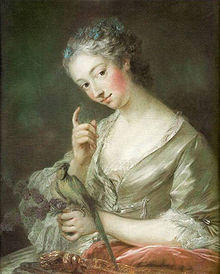Madame de Prie | |
|---|---|
| Marquise de Prie | |
 Madame de Prie after Jean Baptiste Van Loo. | |
| Full name Jeanne Agnès Berthelot de Pléneuf | |
| Born | 1698 Paris, France |
| Died | 7 October 1727 (aged 29) Courbépine, France |
| Spouse(s) | Louis, Marquis of Prie |
| Issue none | |
| Father | Étienne Berthelot de Pléneuf |
Jeanne Agnès Berthelot de Pléneuf, marquise de Prie (1698 – 7 October 1727), was a French noblewoman who for a brief period exercised extraordinary control of the French court during the reign of King Louis XV.
Life
She was the daughter of the financier Étienne Berthelot de Pléneuf. At the age of fifteen she was married to Louis, marquis de Prie, and went with him to the court of Savoy at Turin, where he was ambassador.[1]
At the age of 21, she returned to France, and was soon the declared mistress of Louis Henri, Duke of Bourbon. During his ministry (1723–1725) she dominated the royal court. She engineered the marriage of Louis XV of France to Marie Leszczynska instead of to Mademoiselle de Vermandois, the younger sister of the Duke of Bourbon. In 1725, her scheme to have Bourbon's rival Fleury exiled failed. Instead, Fleury was recalled and Bourbon banished to Chantilly.
In 1725, at the time of Louis XV's marriage, she brought Voltaire to court. Thanks to her, three pieces by Voltaire were included in the wedding festivities.[2]
Madame de Prie herself was exiled to Courbépine, where she committed suicide the next year.[1]
Her exile from the court and suicide are the subject of a short fictional work by Stefan Zweig, "Geschichte eines Unterganges" or "Story of a Downfall" (1910), published in 2005 as "Twilight".
Charlotte Rampling played de Prie in the 1996 TV movie La dernière fête, titled in English The Fall of the Marquise de Prie.
Sources
- M.H. Thirion, Madame de Prie (Paris, 1905).
References
- ^ a b Chisholm 1911.
- ^ Zinsser, Judith (2006). Daring Genius of the Enlightenment. NY, NY: Penguin. p. 64. ISBN 9780143112686.
- Attribution
- Chisholm, Hugh, ed. (1911). . Encyclopædia Britannica (11th ed.). Cambridge University Press.
- La dernière fête at IMDb